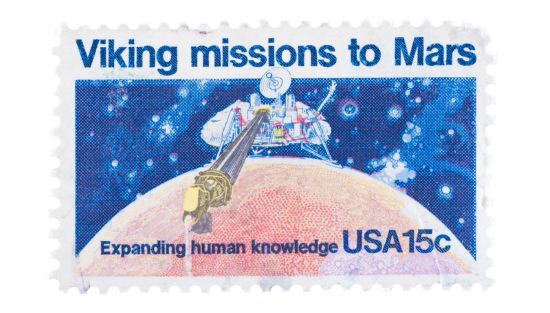During America’s bicentennial in 1976, it put two Viking-named landers on the Martian surface. I have written about the controversial debates on whether the onboard experiments that accompanied these two discovered existing life or an alien chemistry that mimicked what looked like it.
The main test the two Viking landers conducted was called the Label Release Experiment. It involved testing a sample of soil dug up from the surface. The soil was placed in a sealed compartment on board the lander. A dilute aqueous solution with uniformly labelled carbon compounds was added to the soil. The atmospheric output of the soil was measured to monitor the appearance of radioactive gasses. The experiment was then repeated using a second soil sample heated to 160 degrees Celsius (320 Fahrenheit). The atmospheric output was measured again.
At the time although the data indicated microbial life might have produced the results seen, NASA chose to err on the side of caution and not announce life on Mars in the present. Revisiting the data from the two Viking landers years later produced a different conclusion that the evidence of microbial life on Mars was 99% certain.
A new report suggests that the Viking lander experiments killed the life it extracted from the samples according to Dirk Schulze-Makuch, an astrobiologist at the Technische Universität Berlin in Germany. In a commentary appearing in the September 27, 2024 edition of Nature Astronomy. Dirk writes that the use of liquid water in the experiment was a mistake.
Why? Martian conditions are drier than any desert on Earth, and in the driest desert, the Atacama in South America, microbes draw their water not from liquid but from salts that absorb moisture from the atmosphere. The presence of water is toxic to these microbes, with Dirk noting that even one drop could kill.
Dirk believes that following NASA’s liquid water strategy to find evidence of life on Mars and elsewhere in the Solar System may be wrong. He suggests following the salt approach.
Dirk believes that Mars had lots of surface and subsurface water around 4 billion years ago. Over time, with a limited magnetic field to protect the planet from solar and cosmic radiation, Mars lost much of its atmosphere and became a perpetual cold desert. Any life that started on Mars back then would have adapted to the planet’s drying out.
In studies in the Atacama after rare torrential rains, scientists have observed that 70 to 80% of indigenous bacteria die from too much water. Dirk believes that’s what happened to the microbial life on Mars when exposed to the Lab Release Experiments conducted by the two Viking landers.
The salts that could sustain microbial life on Mars are abundant and include sodium chloride, potassium chloride, chlorates and perchlorates, the latter viewed as a problem for life here on Earth when too much is in the environment. Chlorates and perchlorates hold liquid in much lower temperatures which could make them ideal sources for microbial Martian life.
Several decades after the two Viking landers created controversy, NASA sent a series of rovers to follow the water strategy in the search for past rather than present life on Mars. It seemed like a step back in the search for alien life elsewhere in the Universe. Nevertheless, that has remained the current approach NASA has taken.
The two current active rovers, Curiosity and Perseverance have shown us pictures of old riverbeds on Mars as well as eroded landscapes that appear to have been shaped by wind and water. Where Curiosity’s mission has focused on the habitability of Mars in the past, Perseverance has in its experiments and instrumentation the means to hunt for ancient Martian life and collect specimens for later retrieval. In this pursuit, Perseverance has found carbon-based molecules, in other words, organics using an onboard instrument called SHERLOC which is an acronym for Scanning Habitable Environments with Raman and Luminescence for Organics and Chemicals. States Ken Farley, a Perseverance project scientist, SHERLOC is “really the only instrument that we think has a reasonable chance of finding organic matter at the concentrations that are likely present” on the Martian surface today. SHERLOC results have been described in a paper published in July 2023 in the journal Nature.
Perseverance landed in the Jezero Crater where past evidence of flowing water features are visible. Although the SHERLOC instrumentation isn’t focused on following the water strategy of NASA’s past, in choosing this landing site it certainly suggests NASA continues to be wedded to that approach in its search for life.
For me, the fact that NASA after Viking decided to focus on past habitability seems a misdirection in our search for alien life elsewhere in the Universe. NASA appears to have forgotten the Viking experiments that a new theory suggests may have killed the life it found in two scoops of Martian soil because it chose water rather than water-containing salts in its Lab Release Experiment.
We shouldn’t forget that NASA’s Mars Exploration Program has the ultimate goal of sending humans to the planet. When we introduce humans to Mars a vast biome of exotic life including the microflora and fauna populating our bodies will accompany us along with the water contained within us. Human bodies are 60% water for adult men and 50% for women. How will we protect Martian life from being wiped out by exposure to not just the water but the microflora contained in us?
In a posting about concerns for Martian life that I posted to this site in May 2021, I described the cautionary tale involving the European discovery of the Americas that wiped out 90% of native Americans and a significant amount of the non-human biology of the two continents within a century. Imagine just how disruptive to existing Martian life will we humans be when we land on the Red Planet in the coming decades. I would venture we will probably be far more destructive to Mars than Europeans were to the Americas.









